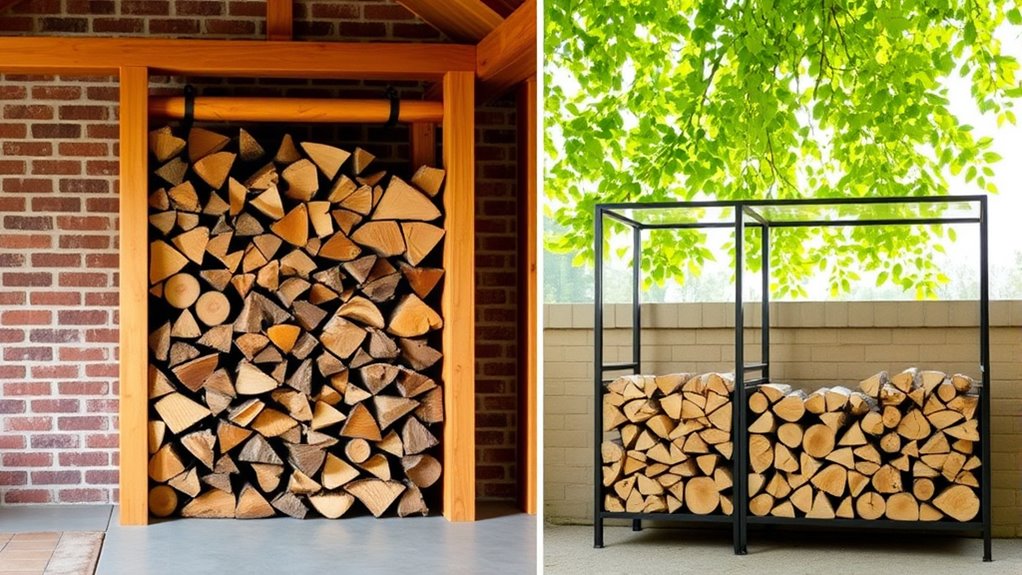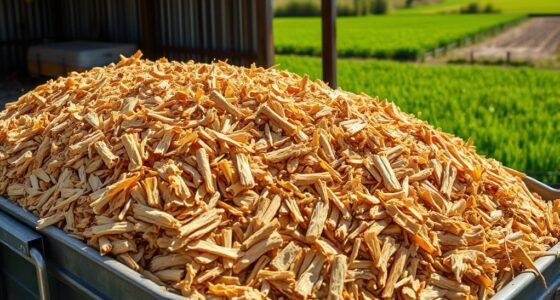When designing wood storage racks indoors and outdoors, focus on selecting fire-resistant or weatherproof materials like galvanized steel or treated wood to make certain safety and durability. Use modular and adjustable systems for flexibility, considering proper ventilation with slatted or angled shelves to keep firewood dry and mold-free. Elevate racks on sturdy platforms to prevent ground moisture contact, and include covers or roofs outdoors for weather protection. To explore more tips and ideas, keep exploring these essential design strategies.
Key Takeaways
- Use fire-resistant, weatherproof materials like treated wood or galvanized steel for safety and durability outdoors.
- Incorporate modular, customizable designs to adapt to available space and changing storage needs indoors and outdoors.
- Ensure proper ventilation with slatted or angled shelves to promote airflow, drying, and prevent mold.
- Elevate outdoor racks on concrete pads or platforms to protect firewood from ground moisture and enhance longevity.
- Design racks at accessible heights with features like sloped shelves or covers for easy use and weather protection.

Have you ever wondered how to create a wood storage rack that’s both efficient and easy to use? The key lies in thoughtful design, starting with the right materials and structure. Using fireproof materials is essential, especially if your storage is indoors or near heat sources, to reduce fire hazards. Metal racks with fire-resistant coatings or treated wood options can offer added safety. When designing your rack, consider modular systems that allow you to customize the setup based on your space and needs. Modular systems give you the flexibility to expand or reconfigure your storage as your firewood collection grows or changes.
Design your firewood rack with fireproof, modular options for safety and adaptability.
To ensure your wood stays dry and well-ventilated, plan for an open design that promotes airflow. This not only helps the wood dry faster but also prevents mold and rot. For indoor storage, you might opt for a sturdy metal frame with slatted shelves or a combination of fireproof materials and treated wood. Outdoors, durability becomes even more critical. Use weather-resistant materials like galvanized steel or powder-coated metal, which resist rust and corrosion. Modular systems work well in outdoor setups because they can adapt to uneven terrain or limited space, allowing you to add or remove sections without rebuilding the entire structure.
When designing for both environments, think about accessibility. Make sure your racks are at a comfortable height for loading and unloading. Incorporate angled or sloped shelves if you want your firewood to slide forward easily. For outdoor racks, consider adding a roof or cover to shield your firewood from rain and snow, extending its usability. Installing the racks on concrete pads or elevated platforms prevents direct contact with damp ground, further protecting your stored wood. Additionally, understanding the importance of best practices in storage can help maintain your wood’s quality over time.
Security and safety are paramount, especially indoors. Ensure your fireproof materials are non-combustible and meet safety standards. If you’re using modular systems, verify that each component is sturdy and properly anchored to prevent tipping or collapse. Regularly inspect your rack for signs of wear or damage, replacing any compromised parts promptly. Inside and outside, maintaining good airflow, protection from the elements, and fire-resistant features will make your wood storage safer and more efficient.
Designing a wood storage rack might seem straightforward, but paying attention to materials, modularity, and safety measures makes all the difference. With the right setup, you’ll keep your firewood organized, dry, and ready to use whenever you need it—making the whole process easier and safer for you.
Frequently Asked Questions
How Do I Prevent Wood Rot in Outdoor Racks?
To prevent wood rot in outdoor racks, you should focus on moisture control and pest prevention. Make sure your rack is elevated off the ground to reduce moisture exposure and allows air circulation. Use weather-resistant materials like treated wood or metal. Regularly inspect and clean your rack, removing debris and signs of pests. Applying a protective sealant can also help guard against moisture, extending the life of your stored wood.
What Materials Are Best for Indoor Wood Racks?
Like a well-crafted story, your indoor wood rack should blend function and style. Opt for materials like cedar, bamboo, or treated pine, which offer durability and wood rack aesthetics that complement your space. These materials resist warping and pests, ensuring longevity. Choose space-saving solutions such as wall-mounted racks or compact stacking units, making your wood storage both practical and visually appealing, just like a good tale that leaves a lasting impression.
How Do I Ensure Proper Air Circulation?
To guarantee proper air circulation, follow ventilation tips like leaving space between logs and avoiding overcrowding. Place your rack in a well-ventilated area, preferably away from walls or heat sources, to promote airflow. Adjust the rack placement to maximize ventilation, and consider adding slats or gaps in the rack design. Regularly check for moisture buildup and rotate your wood to keep it dry and properly aired.
Can I Build a Portable Wood Rack?
Yes, you can build a portable wood rack by incorporating a portable design and mobility options like wheels or casters. Use sturdy materials that can handle the weight of your firewood and make certain the rack is lightweight enough to move easily. Attach handles or grips for better maneuverability, and consider a compact, balanced structure. This way, you can effortlessly relocate your wood storage wherever you need it.
How Do I Store Treated vs. Untreated Wood Safely?
To store treated versus untreated wood safely, keep treated wood off the ground on a rack to prevent moisture contact, which can cause decay. Store untreated wood separately, preferably in a covered, well-ventilated area to avoid mold and pests. Always consider wood treatment types, as treated wood may contain chemicals requiring specific storage safety measures. Proper organization and ventilation guarantee your wood remains in good condition and safe to use.
Conclusion
Now that you know how to design wood storage racks for both indoors and outdoors, you’re ready to create a safe, organized space for your firewood. Remember, proper storage not only keeps your wood dry and ready but also protects your home and improves safety. Isn’t it worth investing a little effort now to avoid bigger problems later? With the right design, you’ll enjoy easy access and peace of mind all year round.











